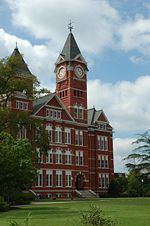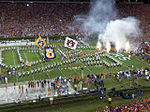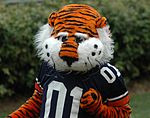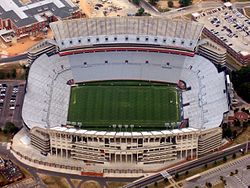- Jordan–Hare Stadium
-
Jordan–Hare Stadium Former names Auburn Stadium (1939–1949)
Cliff Hare Stadium (1949–1973)Location 251 South Donahue Drive, Auburn, Alabama 36849 Coordinates 32°36′8″N 85°29′21″W / 32.60222°N 85.48917°WCoordinates: 32°36′8″N 85°29′21″W / 32.60222°N 85.48917°W Opened November 9, 1939[1] Expanded 1949, 1955, 1960, 1970, 1980, 1987, 2000, 2003 Owner Auburn University Operator Auburn University Surface Grass Construction cost $1,446,900
($22.9 million in 2011 dollars[2])Architect Arnold G. Wurz Capacity 7,500 (1939-1948)
21,500 (1949-1954)
34,500 (1955-1959)
44,500 (1960-1969)
61,261 (1970-1979)
72,169 (1980-1986)
85,214 (1987-1999)
85,612 (2000)
86,063 (2001-2002)
87,451 (2003-present)Tenants Auburn Tigers (NCAA) (1939–present)
Auburn High School Tigers (AHSAA) (1939–1947)Jordan–Hare Stadium is the playing venue for Auburn University's football team located on campus in Auburn, Alabama, USA. The stadium is named for Ralph "Shug" Jordan, the University's winningest football coach, and Cliff Hare, a member of Auburn's first football team as well as Dean of the Auburn University School of Chemistry and President of the Southern Conference. On November 19, 2005, the playing field at the stadium was named Pat Dye Field in honor of former Auburn coach and athletic director Pat Dye. The stadium reached its current seating capacity of 87,451 with the 2004 expansion and is the twelfth largest stadium in the NCAA. By the end of the 2006 season, it was estimated that 19,308,753 spectators had attended a football game in Jordan–Hare.
Jordan–Hare Stadium regularly makes lists of the best gameday atmospheres and most intimidating places to play.[1] [2] [3]
History
The stadium, then known as Auburn Stadium with 7,290 seats, hosted its first game on November 10, 1939, between the Auburn and Georgia Tech freshmen teams.[3] About one month later, the stadium was dedicated and the first college football game was played against the University of Florida on November 30, 1939 under head coach, Jack Meagher. By the time the stadium was renamed Cliff Hare Stadium in 1949, it had grown to a capacity of 21,500. Shug Jordan became head coach of the Tigers in 1951, and he was still coaching when the stadium was renamed to honor him in 1973, making it the first stadium in the United States to be named for an active coach.[4]
Throughout its history, Auburn played games against their traditional rivals at neutral sites rather than Jordan–Hare Stadium. This occurred due to the difficulty in traveling to Auburn during the first half of the 20th century and the capacity of other stadiums. These games included Alabama (played at Legion Field in Birmingham), Tennessee (played at Legion Field in Birmingham or Knoxville), Georgia Tech (played in Birmingham or Atlanta), and Georgia (played at Memorial Stadium in Columbus). As Auburn became more accessible and the stadium expanded in capacity, more games were moved to Jordan–Hare Stadium. The most notable of these matchups occurred on December 2, 1989, when Auburn defeated #2 Alabama in the first Iron Bowl played at Jordan–Hare.
With the addition of the west upper deck in 1980 and the east upper deck in 1987, the stadium became the largest in the state of Alabama until the 2006 and 2010 expansion of Bryant-Denny Stadium (capacity 101,821[5]) at the University of Alabama. The 2004 stadium expansion extended the east upper deck by an additional section on each end, adding more luxury suites and additional general seating to reach the current capacity of 87,451.
In 1998, artist Michael Taylor was commissioned to paint ten large murals on the east-side exterior of the stadium. The paintings depicted the greatest players, teams, and moments from Auburn's football history to that date. [4] In 2006, Auburn updated these murals, including images that recognized great moments in Auburn football history up to 2006. [5] In 2011, Auburn once again updated the murals, recognizing the greatest coaches, players, and teams up until 2011.
Before the 2007 season, a new, $2.9 million, 30-foot (9.1 m) high by 74-foot (23 m) wide high definition Daktronics LED video display was installed in the south end-zone of Jordan–Hare Stadium. Auburn is the first SEC school to install an HD video display and the second in the NCAA (after Texas' Godzillatron).[6]
Gallery
References
- ^ http://shop.ticketluck.com/venues/jordan-hare-stadium-tickets
- ^ Consumer Price Index (estimate) 1800–2008. Federal Reserve Bank of Minneapolis. Retrieved December 7, 2010.
- ^ "3 Football games On Tap This Week For Local Fans; Auburn Hi Tilt Today", Lee County Bulletin, November 9, 1939.
- ^ Facilities: Jordan-Hare Stadium, retrieved July 12, 2008.
- ^ http://www.tidesports.com/article/20100804/NEWS/100809854/1011?Title=Bryant-Denny-expansion-brings-capacity-to-101-821
- ^ "Auburn To Install High Definition Video at Jordan-Hare Stadium". Auburn Athletics Department. 2007-03-27. http://auburntigers.cstv.com/sports/m-footbl/spec-rel/032707aaa.html. Retrieved 2007-05-21.
External links
- Auburn University
- Auburn University athletics website
- Jordan–Hare Stadium at AuburnTigers.com
- Van Plexico's complete history of Jordan–Hare
Preceded by
Drake FieldHome of the
Auburn High School Tigers
1939 – 1947Succeeded by
Felton Little ParkPreceded by
Drake FieldHome of the
Auburn Tigers
1939 – presentSucceeded by
Current
Athletics Auburn Tigers • Football • Men's Basketball • Swimming and Diving
Rivalries: Iron Bowl • Deep South's Oldest Rivalry • Tiger Bowl
Facilities: Jordan–Hare Stadium • Samford Stadium-Hitchcock Field at Plainsman Park • Beard–Eaves–Memorial Coliseum • Auburn Arena
People: Gene Chizik • Nell Fortner • Brett Hawke • Jay Jacobs • Richard QuickCampus Student life Traditions Auburn University traditions • Aubie • Tiger Walk • Toomer's Corner • War Eagle
Outreach Auburn Tigers football All-time Record 702–400–47 (.634)


Head Coaches Current Staff Gene Chizik (Head Coach) • Gus Malzahn (Offensive Coordinator/Quarterbacks) • Ted Roof (Defensive Coordinator/Linebackers) • Jay Boulware (Special-teams Coordinator / Tight Ends) • Trooper Taylor (Assistant Head Coach / Wide Receivers) • Curtis Luper (Running Backs) • Jeff Grimes (Offensive Line) • Mike Pelton (Defensive Line) • Tommy Thigpen (Safeties) • Phillip Lolley (Cornerbacks)Seasons 1892 • 1893 • 1894 • 1895 • 1896 • 1897 • 1898 • 1899 • 1900 • 1901 • 1902 • 1903 • 1904 • 1905 • 1906 • 1907 • 1908 • 1909 • 1910 • 1911 • 1912 • 1913 • 1914 • 1915 • 1916 • 1917 • 1918 • 1919 • 1920 • 1921 • 1922 • 1923 • 1924 • 1925 • 1926 • 1927 • 1928 • 1929 • 1930 • 1931 • 1932 • 1933 • 1934 • 1935 • 1936 • 1937 • 1938 • 1939 • 1940 • 1941 • 1942 • 1944 • 1945 • 1946 • 1947 • 1948 • 1949 • 1950 • 1951 • 1952 • 1953 • 1954 • 1955 • 1956 • 1957 • 1958 • 1959 • 1960 • 1961 • 1962 • 1963 • 1964 • 1965 • 1966 • 1967 • 1968 • 1969 • 1970 • 1971 • 1972 • 1973 • 1974 • 1975 • 1976 • 1977 • 1978 • 1979 • 1980 • 1981 • 1982 • 1983 • 1984 • 1985 • 1986 • 1987 • 1988 • 1989 • 1990 • 1991 • 1992 • 1993 • 1994 • 1995 • 1996 • 1997 • 1998 • 1999 • 2000 • 2001 • 2002 • 2003 • 2004 • 2005 • 2006 • 2007 • 2008 • 2009 • 2010 • 2011Rivalries National Championships 1957 • 2010Conference Championships Perfect Seasons BCS Berths 2004 • 2010Heisman Trophy Winners Conference Affiliations Stadiums Related National Championships: 2 • Conference Championships: 11 • Perfect Seasons: 7 • Bowl Appearances: 36 • Consensus All-Americans: 66 • Heisman Winners: 3Football stadiums of the Southeastern Conference Eastern Division Western Division Bryant–Denny Stadium (Alabama) • Razorback Stadium (Arkansas, primary) • War Memorial Stadium (Arkansas, secondary) • Jordan–Hare Stadium (Auburn) • Tiger Stadium (LSU) • Davis Wade Stadium (Mississippi State) • Vaught–Hemingway Stadium (Ole Miss)
Future College football venues in Alabama Division I
FBSConference USA SEC Sun Belt Division I
FCSOVC JSU Stadium (Jacksonville State)
Southern SWAC Division II Gulf South SIAC Abbott Memorial Alumni Stadium (Tuskegee) • Albert J. Sloan–Alumni Stadium (Miles) • Stillman Stadium (Stillman)
Division III Independent W. James Samford Jr. Stadium (Huntingdon)
SCAC Panther Stadium (Birmingham–Southern)
NAIA Mid-South Categories:- Auburn High School (Alabama)
- Auburn Tigers football venues
- American football venues in Alabama
- Sports venues in Alabama
- Buildings and structures in Lee County, Alabama
Wikimedia Foundation. 2010.











